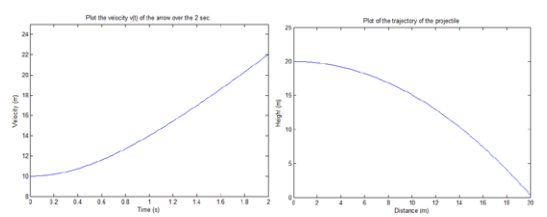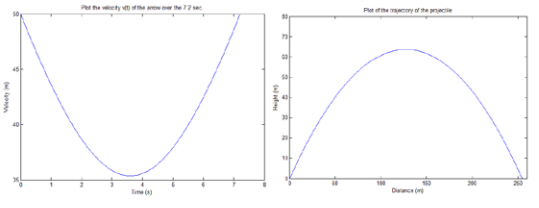Reference no: EM13491476
Part A
1. Write three separate functions (m-files) for x(t), y(t) and v(t) to implement equations 2, 4, and 5 respectively. Note that the time input will be a vector.
2. Given a projectile launched horizontally, (thus the angle of the initial trajectory to 0°), v0 = 10 m/s and y0 = 20 m;
a. Use the functions you created in Part A.1 to compute x(t), y(t) and v(t), where time is from 0 to 2 sec (inclusive) for 200 equal increments.
Hint: linspace().
b. Plot the velocity v(t) of the arrow over the 2 sec.
c. Plot the trajectory, y(t) against x(t), of the arrow over the 2 sec.

3. Given the projectile launched upwards at an angle of 45° (upwards), v0 = 50 m/s and y0 = 0 m (on the ground);
a. Use the function you created in Part A.1 to compute x(t), y(t) and v(t) where time is from 0 to 7.2 sec (inclusive) for 200 equal increments.
b. Plot the velocity v(t) of the arrow over the 7.2 sec.
c. Plot the trajectory, y(t) against x(t), of the arrow over the 7.2 sec.

4. Given the projectile being launched at an angle of 45°, v0 = 20 m/s and y0 = 30 m;
a. Use the function you created in Part A.1 to compute x(t), y(t) and v(t) where time is from 0 to 4.3 sec (inclusive) for 200 equal
increments.
b. Plot the velocity v(t) of the arrow over the 4.3 sec.
c. Plot the trajectory, y(t) against x(t), of the arrow over the 4.3 sec.
5. Explain the difference in trajectory between Part A, 2, 3 and 4.
Part B
1. Write a single function (m-files) that outputs the total time of flight, range of the projectile and the velocity on impact given inputs of g, the angle, v0 and y0. Hint: [timeFlight, range, velocity] = projectile(g, θ, v0, y0) The equations for all the required outputs should be in the same function file and the function should use all the required inputs.
2. Use the functions you created in Part B.1 to compute values for:
a. cannon ball shot upwards at an angle of 30°, v0 = 15 and y0 = 5;
b. cannon ball shot upwards at an angle of 30°, v0 = 20 and y0 = 5;
c. cannon ball shot upwards at an angle of 45°, v0 = 30 and y0 = 0;
d. cannon ball shot upwards at an angle of 45°, v0 = 40 and y0 = 0;
3. Plot the trajectory, y(t) against x(t), of the cannon ball from 0 to the total time you computed in Part B.2.
|
Describe binomial distribution
: A Discrete random variable can be described as Binomial distribution if is satisfies four conditions, Briefly discuss each of these conditions
|
|
How high does she rise during this interval
: A 34-kg girl is bouncing on a trampoline. During a certain interval after she leaves the surface of the trampoline, How high does she rise during this interval
|
|
Define neither serine nor leucine are eluted from the column
: Neither serine nor leucine are eluted from the column because the pH of the elution buffer is too low. C. Neither serine nor leucine are eluted from the column because the pH of the elution buffer is too high. D. Leucine will elute first, followed..
|
|
Find the total distance covered
: A train starts from rest and accelerates at rate of 1.60 m/s2 for 10.0 s. It runs at constant speed for 70.0 s, Find the total distance covered
|
|
Explain the difference in trajectory
: Write a single function that outputs the total time of flight, range of the projectile and the velocity on impact given inputs of g, the angle,
|
|
Find the magnitude and the direction of last leg of journey
: A sailboat sails 180 km west, then 210 km southeast, and then 280 km at 30° east of north. Find the magnitude and the direction of the last leg of the journey
|
|
Define peptidylglycine alpha-amidating monooxygenase
: One enzyme under study in a is peptidylglycine alpha-amidating monooxygenase (PAM). The molecular weight of monomeric PAM is 75,000 g/mol and the enzyme contains 2 copper atoms/enzyme molecule.
|
|
What is the minimum velocity the car can go to make the jump
: a race car is approaching a jump ramp with the ramp angle at 10 degrees and 20 meters long and is 3.47 meters off the ground, what is the minimum velocity the car can go to make the jump
|
|
Explain the catalyzed oxidation of ammonia
: The first step in industrial nitric acid production is the catalyzed oxidation of ammonia. Without a catalyst, a different reaction predominates
|